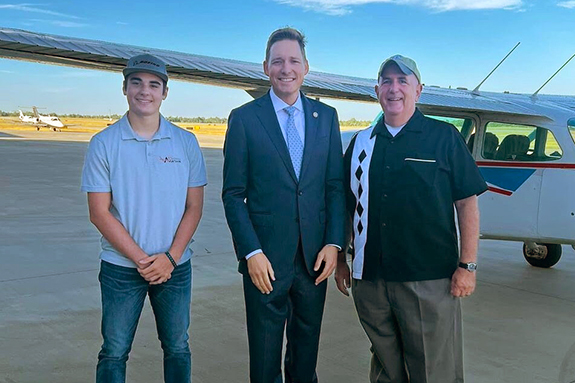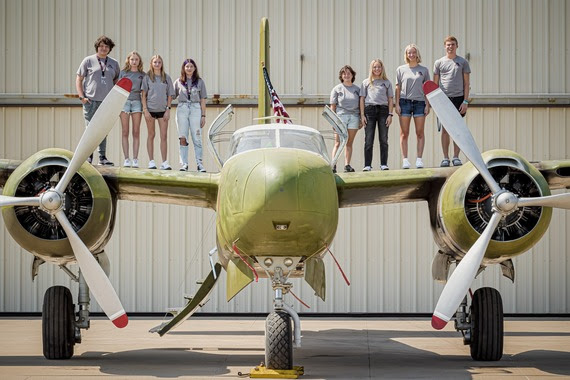For the second consecutive year, the Oklahoma aviation high school roster has been established as leading the way with the highest number of schools teaching the Aircraft Owners and Pilots Association (AOPA) “You Can Fly” high school curriculum. Oklahoma is #1 in the nation for the number of schools that are teaching this aviation and aerospace program in the classroom, 87 schools, nearly double the number of any other state.
Six years after statehood, powered flight came to Oklahoma on March 18, 1910, when Charles Willard flew his Curtiss Pusher airplane to an altitude of three to four hundred feet at a speed of thirty miles per hour. The age of the airplane was born as an increasing number of individuals in the 1920s became pilots. One hundred years later, the Oklahoma skies are once again calling young aviators from what was once grass strips dotting the prairies to what has now evolved into a thriving state airport transportation system with 108 airports supporting communities, economic development, and workforce education across the state.
Because of the consistent need for a thriving and sustainable workforce across the state, Governor Kevin Stitt announced in July that Lt. Governor Matt Pinnell will serve as Secretary of Workforce Development in his Cabinet. In the new appointment, Pinnell will work closely with the Departments of Education, Commerce, Aerospace and Aeronautics, and the CareerTech system to emphasize the workforce pipeline and economic development for the state.

“STEM occupations are projected to grow 10.8% by 2031, and our high school aviation programs give students the foundation they need to pursue careers in the field. Many of these students will fill critical roles as pilots, engineers, aircraft technicians, air traffic controllers, and industry support personnel because they have been given a foundational STEM education focused in aerospace,” said Lt. Governor Matt Pinnell.
Oklahoma has a robust history in aviation and aerospace education. In 1928 the Spartan College of Aeronautics and Technology in Tulsa began providing pilot instruction. What is now the Oklahoma Aeronautics Commission was established in 1931 in the transportation sector and began issuing pilot’s licenses that same year. With that same dedication throughout the decades, the Commission established an aviation and aerospace program during the early 1990s that provided grant funds to programs that are still going strong today such as Sooner Flight Academy anchored in the University of Oklahoma Aviation program and Starbase Oklahoma, a program supported by the Department of Defense.
“Oklahoma University’s School of Aviation has seen a 50% jump in enrollment over each of the past two school years, and this year that number doubled to over 350 students that are in aviation management courses, both flying and non-flying,” said Director Eric Wydra, Oklahoma University College of Atmospheric and Geographic Sciences, School of Aviation. “The investment of time and resources made by Oklahoma Aeronautics has created a trusted pipeline of aviation career seekers. This new AOPA program just opened the flow of students to capacity, and we and other Oklahoma colleges and universities are preparing to meet the demand.”
There are over 400 schools in 44 states using the curriculum. Just this year, Oklahoma saw a 34% increase in the number of school districts teaching the program with more signing on each year. The success of the program’s popularity among educators and students is due to the quality of the curriculum. AOPA developed the high school curriculum to introduce students to aerospace and aviation concepts in the hopes that it would help support the industry’s aerospace workforce and bolster the declining pilot population. Oklahoma is using it to highlight the demand for a skilled aerospace workforce.

“Students are rediscovering the importance of math and science as they calculate the lift of an airplane at the end of a runway, how much fuel they will need to reach their destination airport, and why pilots sump and check fuel samples. This is STEM education for a generation of students that will usher us from the age of aviation to optimizing advanced air mobility,” said Paula Kedy, M.A. Ed., the Commission’s Aerospace and Aviation Education Coordinator.
The AOPA courses, which start students in Aviation I as a freshman in high school, are laid out through Aviation IV as Seniors complete capstone projects. The courses are designed to capture the imagination of students from diverse backgrounds and to equip them with the tools to pursue advanced education and careers in aviation, aerospace, and aeronautical fields.
“Oklahoma Aeronautics has been fueling aero education for many decades, and while in those early years, we started small, they were still important foundational efforts that have led us to have one of the most robust aero education programs in the Country,” said Director of the Aeronautics Commission, Grayson Ardies. “The work we are doing now is putting students in the captain’s seat insofar as their ability to choose their future aerospace career paths. We are seeing students choosing Oklahoma colleges to pursue engineering or aviation degrees, looking toward military service in order to serve our country, or joining a CareerTech aviation maintenance program to become an aircraft mechanic. These are exciting times to live in Oklahoma, and many parents and students are realizing that taking aviation classes in high school can motivate and vector them into selecting one of the many available job opportunities that the aerospace industry has to offer.”




